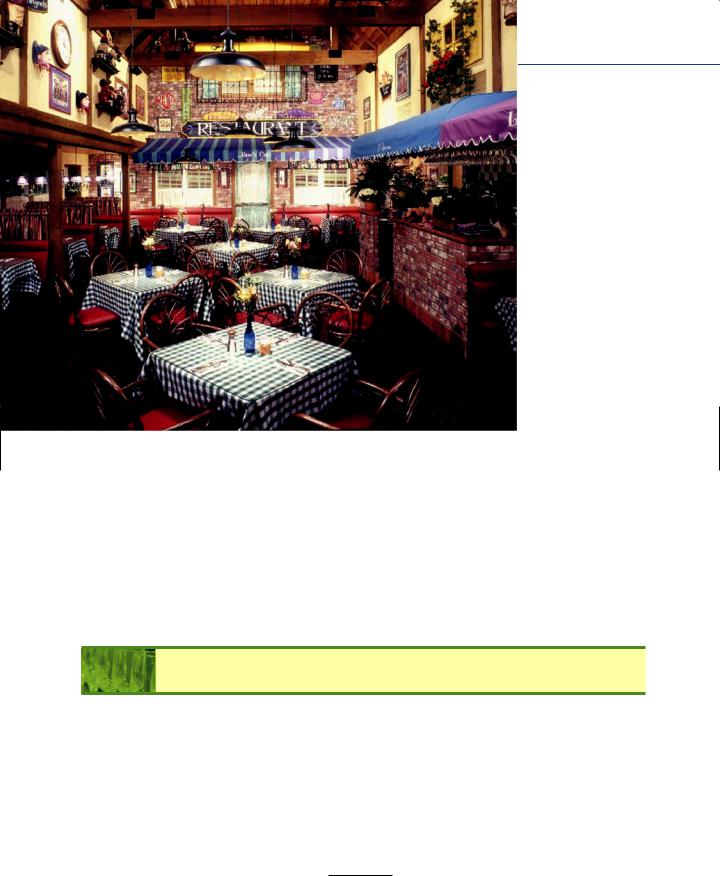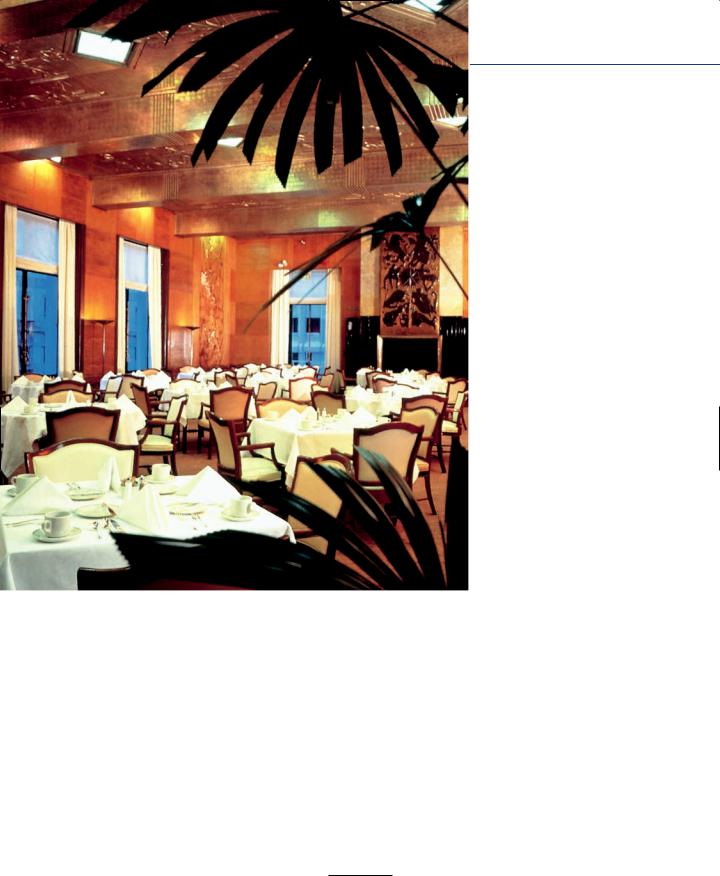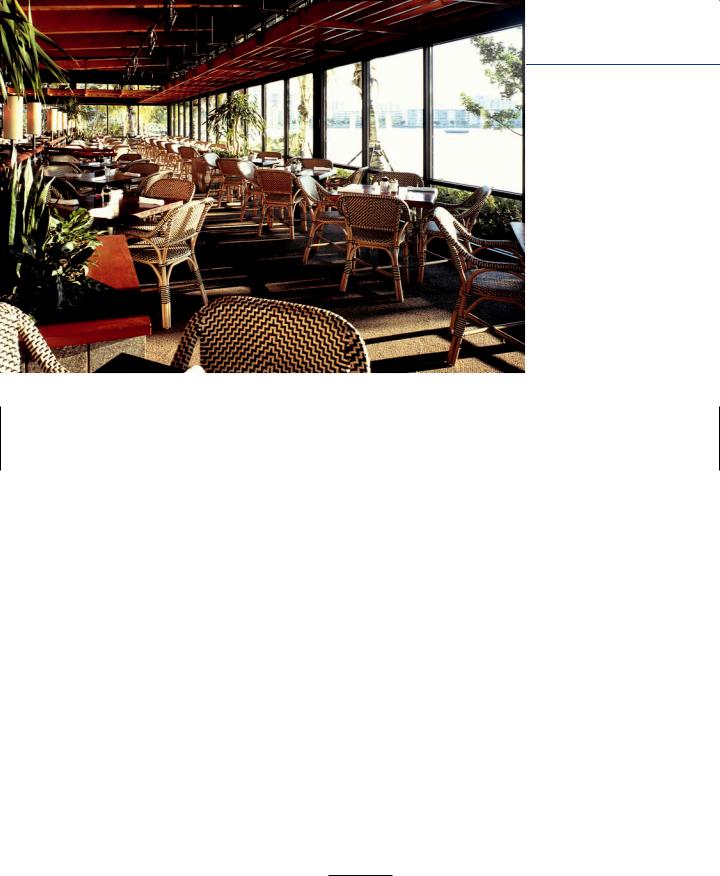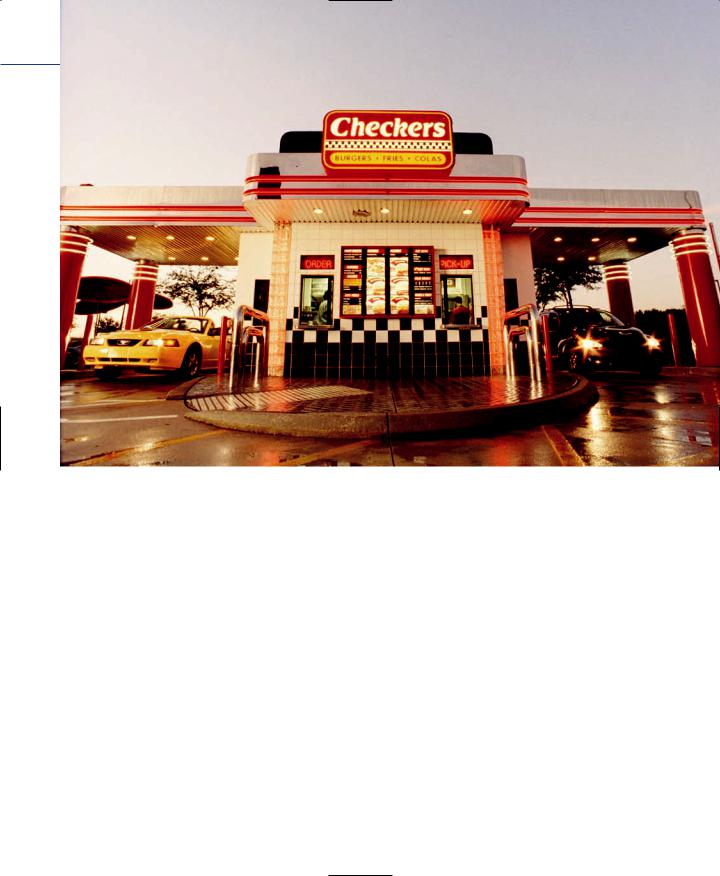
- •CONTENTS
- •PREFACE
- •Content—Benefits for Students
- •Content—Benefits for Instructors
- •Features of the Book for Students and Instructors
- •Supplementary Materials
- •Acknowledgments
- •What Is Hospitality Management?
- •The Manager’s Role in the Hospitality Industry
- •Why Study in a Hospitality Management Program?
- •Planning a Career
- •Employment as an Important Part of Your Education
- •Getting a Job
- •Employment at Graduation
- •The Outlook for Hospitality
- •Summary
- •Managing Change
- •Demand
- •Supply
- •Workforce Diversity
- •The Impact of Labor Scarcity
- •Summary
- •The Varied Field of Food Service
- •The Restaurant Business
- •The Dining Market and the Eating Market
- •Contemporary Popular-Priced Restaurants
- •Restaurants as Part of a Larger Business
- •Summary
- •Restaurant Operations
- •Making a Profit in Food Service Operations
- •Life in the Restaurant Business
- •Summary
- •Chain Restaurant Systems
- •Independent Restaurants
- •Franchised Restaurants
- •Summary
- •Competitive Conditions in Food Service
- •The Marketing Mix
- •Competition with Other Industries
- •Summary
- •Self-Operated Facilities
- •Managed-Services Companies
- •Business and Industry Food Service
- •College and University Food Service
- •Health Care Food Service
- •School and Community Food Service
- •Other Segments
- •Vending
- •Summary
- •Consumer Concerns
- •Food Service and the Environment
- •Technology
- •Summary
- •The Evolution of Lodging
- •Classifications of Hotel Properties
- •Types of Travelers
- •Anticipating Guest Needs in Providing Hospitality Service
- •Service, Service, Service
- •Summary
- •Major Functional Departments
- •The Rooms Side of the House
- •Hotel Food and Beverage Operations
- •Staff and Support Departments
- •Income and Expense Patterns and Control
- •Entry Ports and Careers
- •Summary
- •The Economics of the Hotel Business
- •Dimensions of the Hotel Investment Decision
- •Summary
- •The Conditions of Competition
- •The Marketing Mix in Lodging
- •Product in a Segmented Market
- •Price and Pricing Tactics
- •Place—and Places
- •Promotion: Marketing Communication
- •Summary
- •The Importance of Tourism
- •Travel Trends
- •The Economic Significance of Tourism
- •The United States as an International Tourist Attraction
- •Businesses Serving the Traveler
- •Noneconomic Effects of Tourism
- •Summary
- •Motives and Destinations
- •Mass-Market Tourism
- •Planned Play Environments
- •Casinos and Gaming
- •Urban Entertainment Centers
- •Temporary Attractions: Fairs and Festivals
- •Natural Environments
- •On a Lighter Note. . .
- •Summary
- •Management and Supervision
- •The Economizing Society
- •The Managerial Revolution
- •Management: A Dynamic Force in a Changing Industry
- •What Is Management?
- •Summary
- •Why Study Planning?
- •Planning in Organizations
- •Goal Setting
- •Planning in Operations
- •The Individual Worker as Planner
- •Long-Range Planning Tools
- •Summary
- •Authority: The Cement of Organizations
- •Departmentalization
- •Line and Staff
- •Issues in Organizing
- •Summary
- •Issues in Human-Resources Management
- •Fitting People to Jobs
- •Recruiting
- •Selection and Employment
- •Training
- •Retaining Employees
- •Staff Planning
- •Summary
- •The Importance of Control
- •Control and the “Cybernetic Loop”
- •Tools for Control
- •Summary
- •Leadership as Viewed by Social Scientists
- •Why People Follow
- •Leadership Theories
- •Communication
- •The Elements of Leading and Directing
- •Developing Your Own Leadership Style
- •Summary
- •A Study of Service
- •Rendering Personal Service
- •Managing the Service Transaction
- •How Companies Organize for Service
- •Summary
- •INDEX

More customers are looking for
restaurants that offer comfort and value. (Courtesy of Mimi’s Café.)
First, we need to consider the basic distinction between the dining market and the eating market. We will look at dining operations such as fine dining and casual dining restaurants, and at the other extreme, we will discuss the rapidly growing off-premise operations, such as takeout and delivery (much of which is now being referred to as home meal replacement), that are accounting for major growth in the eating market. In the next major section of this chapter, we will consider contemporary popular-priced restaurants that represent the largest segments of the restaurant business today. These include the quick-service restaurants and midscale operations such as family restaurants. The chapter will conclude with a consideration of restaurants as part of larger establishments.
The Dining Market and the Eating Market
One of the twentieth century’s most innovative restaurateurs, Joe Baum (former president of Restaurant Associates), suggested that a primary role of a restaurant is to transform the act of eating into something greater and more civilized. This is one
of the great challenges of the restaurant operator today.
Building upon this, we can say that restaurants serve both our social needs and our biological needs. We can divide restaurants into those serving predominantly our
68

The Dining Market and the Eating Market |
69 |
social needs (the dining market) and those serving our biological needs (the eating market). Nearly all meals eaten in the company of others have a social dimension, just as the most formal state dinner has its biological aspect. The main purpose, however, is usually clear.
DINING WELL
People dine out for a variety of reasons, including to escape from boredom, to socialize, to avoid drudgery, to be waited on, to have foods different from those served at home, and for convenience.
Because dining (as opposed to eating) is predominantly a social event, service is important. Servers are expected to be friendly, as signified by a warm smile, and accurate. The role of the server is, therefore, much more than a mechanical one. In the relatively expensive restaurants serving the dining market, the operation that falls short on service is likely to lose customers quickly. (Service is discussed in more detail in the final chapter of the book.)
The demographics of such customers, as always, are important. The guest who dines in a fine restaurant usually is older, is more highly educated, has a higher-than- average income, and is well accustomed to dining out and traveling. We will now try to break the dining market into further subsegments.
Fine-Dining Restaurants. Most full-service, fine-dining establishments are small, independent operations, some seating fewer than 100 guests, which is quite small by today’s standards. Despite their modest capacities, these restaurants succeed (or don’t) because of their quality. Many are staffed by trained professional chefs who have brought with them a craft tradition that dates back to the Middle Ages.
Excellence is the absolute prerequisite in fine dining because the prices charged are necessarily high. An operator may do everything possible to make the restaurant efficient, but the guests still expect careful, personal service: food prepared to order by highly skilled chefs and delivered by expert servers. Because this service is, quite literally, manual labor, only marginal improvements in productivity are possible. For example, a cook, server, or bartender can move only so much faster before she or he reaches the limits of human performance. Thus, only moderate savings are possible through improved efficiency, which makes an escalation of prices inevitable. (It is an axiom of economics that as prices rise, consumers become more discriminating.) Thus, the clientele of the fine-dining restaurant expects, demands, and is willing to pay for excellence.
These distinguished operations generally require the right combination of three elements: a large market, skilled workers, and devoted management. First, because of the high prices they must charge, most are located in or near large population centers

Fine dining offers the experience of luxury and enhances the importance of special occasions. (City Club of San Francisco; Courtesy of ClubCorp.)
or in major tourism areas where there is a sufficiently large number of people with high incomes to ensure a satisfactory sales volume. Fine dining accounts for only about 2 percent of total food service sales each year, but the majority of its customers are repeat customers. Getting and keeping customers is critical in most segments but is particularly important in fine dining.
A second requirement of these restaurants is having qualified personnel: chefs, servers, and the like with highly polished skills. It was, for a time, difficult to find this kind of staff, but the growth in culinary education and training programs has reduced the shortage somewhat. People with these skills are most likely to be found in large metropolitan areas, although there are some obvious exceptions to this generalization.
70

The Dining Market and the Eating Market |
71 |
A third and most important requirement for successful fine-dining restaurants is a special devotion from the key operating personnel, especially the owners and/or managers. The hours tend to be long, and the owners, although they may be amply compensated, generally devote their lives to their work.
As we have already noted, fine-dining sales have been falling for the last two decades due to a growing preference for all things casual. According to a study by
Restaurants & Institutions magazine, 40 percent of respondents reported that they had dined less in fine dining restaurants than in the previous year.7 Although some part of this decline may be due to price sensitivity, the recession, and health concerns about rich foods, there seems to have been a basic shift in consumer service preferences as well. Older patrons have been accustomed to the kind of service rituals that characterize these operations. As younger customers advance in income and age to the point where they might be customers for fine dining, they may be put off by overly formal dining. In many instances, they prefer an upscale experience that is more casual. While fine dining has declined in popularity in recent years, it is certainly here to stay: Consumers are simply viewing the fine dining experience in a slightly different light. For a large segment of the population, casual upscale dining offers an attractive alternative.
Casual Upscale Dining. The question that arises, then, is what has taken the place of the fine-dining segment? One of the fastest-growing segments of food service is what is referred to as “casual dining.” Casual dining appeals to consumers on many levels. In fact, the casual segment can be further segmented by price and service level. Casual upscale dining represents those restaurants that are at the top end of the casual segment. They may even be referred to as “casual fine dining.” Some examples, on a national level, include Houston’s, which has a very devoted clientele, Mimi’s Café, the Cheesecake Factory, P. F. Chang’s, and the Chart House (recently purchased by Landry’s). Casual upscale dining, in particular, seems to have filled part of the void left by fine dining.
The movement of the baby boomers into their peak earning years partially explains the growth of casual upscale dining. As consumers age and more restaurant options are available to them, taste preferences become more sophisticated. Excellence in food is one of the appeals of these restaurants. The menus in casual upscale dining restaurants, and in casual dining in general, have become increasingly sophisticated and interesting in recent years. Another is the topflight service that is offered by many such restaurants. Although meals here are less time-consuming and elaborate than in more formal and higher-priced restaurants, successful casual upscale restaurants deliver professional and attentive service at a significantly lower price than in fine-dining restaurants.
Most casual upscale restaurants have a unifying theme that is pervasive in the design of their menu, interior decor, and often the exterior of the building. Menu specialties are increasingly highly varied and wine lists are ample. Part of the reason for

Houston’s, a leading casual upscale dining chain, pays great attention to detail in the decor of their restaurants. (Courtesy of Houston’s Restaurants.)
the more significant role that this segment is playing is due to the increasing role played by the large chain operators. Multiple-concept chains such as The Hillstone Restaurant Group (formerly Houston’s) play a critical role in defining the casual-dining landscape. The Hillstone Restaurant Group operates several concepts in addition to their flagship brand, including Bandera, Gulfstream, Cherry Creek Grill, Rutherford Grill, Palm Beach Grill, Los Altos Grill, and Café R&D.
Concepts for a new chain operation (whether casual upscale or otherwise) are developed through extensive market research, tested in one or more pilot operations, and, once proven, rolled out to the regional or national market. Sometimes, rather than developing a concept themselves, multiple-concept chains purchase a promising independent operation, fine-tune the concept for a wider market, and then roll it out to regional and national markets. Either of these strategies can prove to be a risky propo- sition—most successful operators have a respectable portfolio of brands that have failed or that did not meet sales expectations and were discontinued.
In contrast to the QSR and midpriced segments with their breakfast/lunch focus, casual upscale restaurants cater to a higher-check-average clientele for the lunch and dinner day parts. Naturally, this results in a higher dollar amount of sales. Some, such as Outback Steakhouse, go so far as to limit their operations to a single meal period (dinner). Casual upscale unit sales are also helped by the addition of alcoholic beverages, which usually add greater profit potential.
Noting the success of the casual upscale segment, many fine-dining operators have made changes. Because of the competitive market, many fine-dining restaurants have
72

The Dining Market and the Eating Market |
73 |
made the decision to move to meet the market demand for a more relaxed atmosphere and more reasonable prices. Other operators made the decision to balance their finedining outlet with a more casual option for their customers—Emeril Lagasse in New Orleans with his namesake restaurant, Emeril’s, and the more casual NOLA is one example. (Lagasse also operates a second fine-dining restaurant, Delmonico, in the same city.)
Some operators closed their fine-dining outlets outright. Kevin Taylor, the operator of the Zenith American Grill in Denver, closed a very successful four-diamond restaurant and opened more casual restaurants, including jou jou and Nicois.
THE EATING MARKET AND ITS DYNAMICS
The eating market consists of those segments that cater primarily to the biological needs as opposed to primarily social needs. Quick-service restaurants, which we will look at in more detail in a moment, constitute a sizable segment of the eating market—one that is patronized by nearly every household. A survey by Restaurants & Institutions magazine revealed some interesting insights into dining-out behavior. Forty-four percent of respondents reported eating in a quick-service restaurant at least once a week. This compared with 35 percent of respondents who reported eating out at least once a week in casual-dining outlets. Two-thirds of households patronize quick-service restaurants frequently; that is, some member of those households buys fast food three or four times a week.8 In other words, these quick-service and midscale restaurant customers are the heart of the eating markets. The quick-service sector, as we noted earlier, is continuing its growth at a compound annual rate of 5 percent from 2005 to 2006. Off-premise dining is another segment of the restaurant business that continues to grow.
As discussed earlier, the three main components of off-premise dining are takeout, drive-through, and delivery. Home meal replacement, still a relatively new term, can include any or all of these components. HMR (or the even more current term “meal solutions”) is usually meant to encompass a good portion of this market, specifically those prepared food products that are purchased away from the home but consumed at home. Each of these has maintained roughly the same share of off-premise sales for some years. Together they account for over 50 percent of the entire food service market. The largest part of off-premise sales is takeout, with nearly two-thirds of the traffic (visits) and volume. Drive-through is the second most frequent. Either way one views it, off-premise dining represents an important part of food service industry sales. While it all began with fast food, it has spread across other segments to the point where there are now establishments designed strictly for customers to pick up fully prepared food to be brought home. Such examples include Foodies Kitchen (New Orleans), Tasteez (Denver), and Eatzi’s (Texas). Such operations are best described as a hybrid of restaurant and upscale supermarket. Each of the three primary areas identified above are discussed in turn.

74Chapter 3 The Restaurant Business
Takeout. Takeout is an old, established part of food service, but its continued growth has increased its prominence. Consumers have indicated their interest in takeout with their growing patronage. Not surprisingly, operators have responded to this consumer interest. Nearly all quick-service operations offer take-out meals, and quick-service operations account for the lion’s share of takeout sales. The vast majority of midscale table service restaurants also offer takeout, as do many upscale operations (which is only increasing). Thus, increased sales of takeout food are fueled not only by consumer preference but by the wide availability of takeout food service. Restaurants & Institutions magazine reports that restaurants such as Golden Corral and Piccadilly Cafeterias represent a new breed of restaurants that are trying to capture a piece of the growing takeout business.9 Both companies have found that they were able to operationalize the process and that it represents a significant part of their overall business.
Drive-Through. Initially, drive-through service was introduced as a part of an existing quick-service restaurant, and that is still an important use of the drive-through. Since its introduction, though, it has become an integral part of the QSR service strategy. Further, it should be mentioned, that it is no longer limited to the burger chains but has also been adopted by such chains as Starbucks and is also being tested by 7-Eleven.
The drive-through came into its own, however, with the introduction of the double drive-through. These operations enjoyed the advantage of low capital costs because of the small building and relatively small size lot on which they could be fitted. Highly simplified menus gave them an operating cost advantage, too, and fast delivery times appealed to many customers.
It quickly became apparent to QSR operators that the double drive-through was a serious competitive threat, and the competitive response was not long in coming. Existing QSRs improved their drive-through facilities and used their powerful brands in a promotional push. Many QSRs that lacked drive-through facilities added them. In the shakeout that followed, a number of double drive-through chains, which had been growing rapidly, went out of business. Some survived, but these now serve a specialty niche, and the dominant force in the drive-through market is the branded QSRs, such as McDonald’s and Burger King. Certain companies, such as Checkers and Rally’s, are defined by the double drive-through concept.
Delivery. Delivery is a slightly different segment of the industry. Delivery operations do not fit well in the same unit with table service operations for a variety of reasons. Not only does demand peak just when the dining room is busiest (as is also true with takeout), but the parking lot is jammed with customers’ cars just when delivery vehicle traffic in and out is at its peak. Moreover, the skills of the service staff are different. A person who is very effective as a server in face-to-face service will not automatically

Checkers is a major company in the drive-through segment. (Courtesy of © Checkers Drive-In Restaurants, Inc.)
be effective in the telephone contact that is the typical start of a delivery transaction, at least not without specific training and an operating system designed to handle delivery. For these reasons, many companies have found it best to limit delivery operations to separate delivery units. This can result in cost advantages, too, in that they can be located on less expensive real estate.
For the reasons identified above, many of the chains that offer delivery specialize in it. In this way, their entire operation may be based upon this single premise. For instance, many delivery chains use a single telephone number for all units. At the central answering facility, employees take calls at computer terminals. When a customer places an order, the operator asks for his or her phone number and address. Using this information, the order is passed to the nearest unit for dispatch. At the same time, the customer’s name and order go into the computerized guest history system. Then on subsequent calls, the operator is able to bring up the customer’s record using his or her phone number. Thus, when John Doe calls, the operator can say, “Good to hear from you again, Mr. Doe. Would you like to have your usual pepperoni and mushroom? Shall we deliver it to the
75
